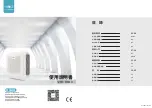
131
YORK INTERNATIONAL
FORM 100.50-NOM1 (604)
8
FAULT DESCRIPTIONS
Failure Modes
Troubleshooting the rooftop unit is aided by the fact
that the unit stores the last 12 unit “faults” in its history
buff er, and can be viewed under the History key. The
History navigation is explained in this manual under the
section on Menu Navigation and Display Descriptions.
Anytime the unit has a Fault, the System Alarm LED,
just to the right of the display will be illuminated.
Fault Descriptions
The Fault Description Table, Table 34, classi
Þ
es faults
into two categories, T
rouble
faults and
Alarm
faults.
Trou ble faults will cause the event to be recorded into
the his to ry buffer, but
will not
shut the unit down.
Alarm faults will cause the event to be recorded into
the his to ry buff er, and
will
cause the unit to be shut
down. Both type of faults will illuminate the LED on
the OptiLogic key pad.
Clearing Faults
The nature of the shutdown determines if the unit
re quires a “manual reset”, verses an “auto reset”. A
man u al reset requires removal of power from the
roof top unit control board. This can most easily be
ac com plished by cycling power at the unit disconnect
switch. An auto reset will be reset automatically once
the fault has cleared itself.
Remember, when power is recycled, the control board
goes through a 5 minute self-check, with the display
showing version, address, status “no Comm”, and start-
up “Ok Ok Ok” being displayed.
MOD UNT Communication Fault
When the Expansion Input/Output controller is con-
nect ed via the N2 bus to the controller for a Re frig er ant
Transducer Package, Low Ambient operation, or Flex-
Sys option, the communication status will be mon i tored.
A fault is declared if the com mu ni ca tion is lost.
Analog Input Faults
All analog inputs will be monitored for reliability
according to the type of input connected and the range
speci
Þ
ed. The controller monitors all AI inputs to
determine if the value at the input is within an ac cept able
range. These values are listed in Table 28. The engineer-
ing units represented are also listed as ap pli ca ble.
Temperature Inputs
Temperature inputs will be monitored for reliability.
If the controller determines that the input is not within
the accepted range (shorted or open), a fault will be
de clared.
Voltage Inputs
Voltage inputs will be compared with the allowed volt-
age range as shown in Tables 28. Inputs with voltages
outside of this range will be declared un re li able and a
fault will be declared.
Negative Pressure Safety Switch
This safety device is in series with the analog output to
the outside air damper when the unit is con
Þ
gured for
an Air Measuring station. A Negative Pressure safety
switch will be factory installed in the
Þ
lter section of
the unit whenever a Minimum Air Measuring Station is
installed (none for full Air Measuring Sta tion), and will
be located upstream of the
Þ
lters. This switch will open
at negative 4 iwg for the purpose of pre vent ing an exces-
sive negative pressure in the return sec tion, should the
outside air damper fail. If the out side air damper fails
(fails closed), the Primary Unit Controller will drive the
return air dampers closed to increase the out side air be-
cause it sees a decrease in air
ß
ow (damp ers are closed).
If the pressure ex ceeds – 4 iwg as a result of the return
damp ers closing, the negative pressure switch will open
and remove power from the return damper actuator. The
return damper ac tu a tor is “fail open” and will open the
return dampers to relieve the negative pressure. The
Primary Unit Controller does not monitor the neg a tive
pressure switch. As such this safety is used only to
prevent damage to the unit pan els, and the failure of the
outside air damper will con tin ue to exist until no ticed
by service or maintenance personnel.
















































